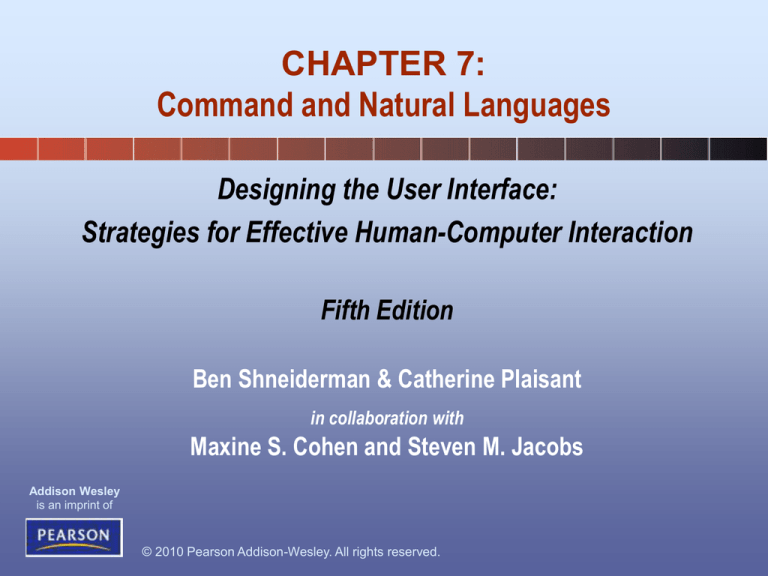
CHAPTER 7:
Command and Natural Languages
Designing the User Interface:
Strategies for Effective Human-Computer Interaction
Fifth Edition
Ben Shneiderman & Catherine Plaisant
in collaboration with
Maxine S. Cohen and Steven M. Jacobs
Addison Wesley
is an imprint of
© 2010 Pearson Addison-Wesley. All rights reserved.
The Basic Goals
of Language Design
•
•
•
•
•
•
Precision
Compactness
Ease in writing and reading
Speed in learning
Simplicity to reduce errors
Ease of retention over time
1-2
© 2010 Pearson Addison-Wesley. All rights reserved.
7-2
Higher-Level Goals
of Language Design
• Close correspondence between reality and
the notation
• Convenience in carrying out manipulations
relevant to user's tasks
• Compatibility with existing notations
• Flexibility to accommodate novice and
expert users
• Expressiveness to encourage creativity
• Visual appeal
© 2010 Pearson Addison-Wesley. All rights reserved.
1-3
7-3
Functionality to Support
User’s Tasks
Users do wide range of work:
• text editing
• electronic mail
• financial management
• airline or hotel reservations
• inventory
• manufacturing process control
• gaming
© 2010 Pearson Addison-Wesley. All rights reserved.
1-4
7-4
Functionality to Support
User’s Tasks (cont.)
Designers should
• determine functionality of the system by studying users' task domain
• create a list of task actions and objects
• abstract this list into a set of interface actions and objects
• represent low-level interface syntax
• create a table of user communities and tasks, with expected use
frequency
• determine hierarchy of importance of user communities (i.e. prime
users)
• evaluate destructive actions (e.g. deleting objects) to ensure
reversibility
• identify error conditions and prepare error messages
• allow shortcuts for expert users, such as macros and customizing
system parameters
© 2010 Pearson Addison-Wesley. All rights reserved.
1-5
7-5
1-6
© 2010 Pearson Addison-Wesley. All rights reserved.
7-6
Command-Organization
Strategies
A unifying interface concept or metaphor aids
– learning
– problem solving
– retention
Designers often err by choosing a metaphor closer to
machine domain than to the user's task domain.
Simple command set
– Each command is chosen to carry out a single task. The number
of commands match the number of tasks.
– For small number of tasks, this can produce a system easy to
learn and use.
– E.g. the vi editor of Unix.
1-7
© 2010 Pearson Addison-Wesley. All rights reserved.
7-7
Command plus
arguments/options
•
Command plus arguments
Follow each command by one or more arguments that indicate objects to be
manipulated, e.g.
– COPY FILEA, FILEB
– DELETE FILEA
– PRINT FILEA, FILEB, FILEC
•
Keyword labels for arguments are helpful for some users, e.g. COPY
FROM=FILEA TO=FILEB.
•
Commands may also have options to indicate special cases, e.g.:
– PRINT/3,HQ FILEA
– PRINT (3, HQ) FILEA
– PRINT FILEA -3, HQ
•
to produce 3 copies of FILEA on the printer in the headquarters building.
Error rates and the need for extensive training increase with the number of
possible options.
1-8
© 2010 Pearson Addison-Wesley. All rights reserved.
7-8
The Benefits of Structure
Human learning, problem solving, and memory are greatly facilitated by
meaningful structure.
• Beneficial for
– task concepts
– computer concepts
– syntactic details of command languages
Consistent Argument Ordering
Inconsistent order of arguments
Consistent order of arguments
SEARCH
TRIM
REPLACE
INVERT
SEARCH
TRIM
REPLACE
INVERT
file no, message id
message id, segment size
message id, code no
group size, message id
message id, file no
message id, segment size
message id, code no
message id, group size
1-9
© 2010 Pearson Addison-Wesley. All rights reserved.
7-9
Hierarchical command structure
– The full set of
commands is
organized into a
tree structure
– 5x3x4 = 60 tasks
with 5 command
names and 1 rule
of formation
Action
Object
Destination
CREATE
File
File
DISPLAY
Process
Local printer
REMOVE
Directory
Screen
COPY
Remote
printer
MOVE
1-10
© 2010 Pearson Addison-Wesley. All rights reserved.
7-10
Symbols versus Keywords
Command structure affects performance
Symbol Editor
Keyword Editor
FIND:/TOOTH/;-1
BACKWARD TO "TOOTH"
LIST;10
LIST 10 LINES
RS:/KO/,/OK/;*
CHANGE ALL "KO" TO "OK"
1-11
© 2010 Pearson Addison-Wesley. All rights reserved.
7-11
Naming and Abbreviations
There is often a lack of consistency or obvious strategy for
construction of command abbreviations.
Specificity Versus Generality
Infrequent, discriminating words
insert
delete
Frequent, discriminating words
add
remove
Infrequent, nondiscriminating words
amble
perceive
Frequent, nondiscriminating words
walk
view
General words (frequent, nondiscriminating)
alter
correct
Nondiscriminating nonwords (nonsense)
GAC
MIK
Discriminating nonwords (icons)
abc-adbc
abc-ab
© 2010 Pearson Addison-Wesley. All rights reserved.
1-12
7-12
Six Potential
Abbreviation Strategies
1.
2.
3.
4.
5.
6.
Simple truncation: The first, second, third, etc. letters of each
command.
Vowel drop with simple truncation: Eliminate vowels and use
some of what remains.
First and last letter: Since the first and last letters are highly
visible, use them.
First letter of each word in a phrase: Use with a hierarchical
design plan.
Standard abbreviations from other contexts: Use familiar
abbreviations.
Phonics: Focus attention on the sound.
1-13
© 2010 Pearson Addison-Wesley. All rights reserved.
7-13
Guidelines for using
abbreviations
Ehrenreich and Porcu (1982) offer this set of guidelines:
•
•
•
•
•
•
•
•
A simple primary rule should be used to generate abbreviations for most items; a
simple secondary rule should be used for those items where there is a conflict.
Abbreviations generated by the secondary rule should have a marker (for example,
an asterisk) incorporated in them.
The number of words abbreviated by the secondary rule should be kept to a
minimum.
Users should be familiar with the rules used to generate abbreviations.
Truncation should be used because it is an easy rule for users to comprehend and
remember. However, when it produces a large number of identical abbreviations
for different words, adjustments must be found.
Fixed-length abbreviations should be used in preference to variable-length ones.
Abbreviations should not be designed to incorporate endings (ING, ED, S).
Unless there is a critical space problem, abbreviations should not be used in
messages generated by the computer and read by the user.
1-14
© 2010 Pearson Addison-Wesley. All rights reserved.
7-14
Command-language guidelines
1-15
© 2010 Pearson Addison-Wesley. All rights reserved.
7-15
Natural Language in Computing
• Natural-language interaction
• Natural-language queries and question
answering
• Text-database searching
• Natural-language text generation
• Adventure games and instructional systems
1-16
© 2010 Pearson Addison-Wesley. All rights reserved.
7-16
Natural Language in Education
CognitiveTutor traces student progress in mastering skills and
concepts, then assigns individually tuned problems
Communicating with students via Natural Language
© 2010 Pearson Addison-Wesley. All rights reserved.
1-17
7-17








